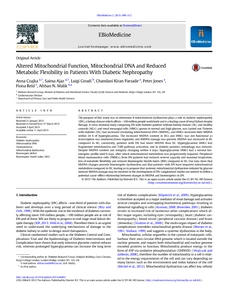Czajka, A; Ajaz, S; Gnudi, L; Parsade, CK; Jones, P; Reid, F; Malik, AN
(2015)
Altered Mitochondrial Function, Mitochondrial DNA and Reduced Metabolic Flexibility in Patients With Diabetic Nephropathy.
EBioMedicine, 2 (6).
pp. 499-512.
ISSN 2352-3964
https://doi.org/10.1016/j.ebiom.2015.04.002
SGUL Authors: Reid, Fiona Dorothy Alexandra
![[img]](https://openaccess.sgul.ac.uk/107477/1.hassmallThumbnailVersion/Altered%20Mitochondrial%20Function%2C%20Mitochondrial%20DNA%20and%20Reduced%20Metabolic%20Flexibility%20in%20Patients%20With%20Diabetic%20Nephropathy..pdf)  Preview |
|
["document_typename_cannot open `/data/SGUL/sgul/eprints3/archives/sgul/documents/disk0/00/10/74/77/01/Altered' (No such file or directory)
cannot open `Mitochondrial' (No such file or directory)
cannot open `Function,' (No such file or directory)
cannot open `Mitochondrial'" not defined]
Published Version
Available under License Creative Commons Attribution Non-commercial No Derivatives.
Download (2MB)
| Preview
|
Abstract
The purpose of this study was to determine if mitochondrial dysfunction plays a role in diabetic nephropathy (DN), a kidney disease which affects > 100 million people worldwide and is a leading cause of renal failure despite therapy. A cross-sectional study comparing DN with diabetes patients without kidney disease (DC) and healthy controls (HCs); and renal mesangial cells (HMCs) grown in normal and high glucose, was carried out. Patients with diabetes (DC) had increased circulating mitochondrial DNA (MtDNA), and HMCs increased their MtDNA within 24 h of hyperglycaemia. The increased MtDNA content in DCs and HMCs was not functional as transcription was unaltered/down-regulated, and MtDNA damage was present. MtDNA was increased in DC compared to HC, conversely, patients with DN had lower MtDNA than DC. Hyperglycaemic HMCs had fragmented mitochondria and TLR9 pathway activation, and in diabetic patients, mitophagy was reduced. Despite MtDNA content and integrity changing within 4 days, hyperglycaemic HMCs had a normal bio-energetic profile until 8 days, after which mitochondrial metabolism was progressively impaired. Peripheral blood mononuclear cells (PBMCs) from DN patients had reduced reserve capacity and maximal respiration, loss of metabolic flexibility and reduced Bioenergetic Health Index (BHI) compared to DC. Our data show that MtDNA changes precede bioenergetic dysfunction and that patients with DN have impaired mitochondrial metabolism compared to DC, leading us to propose that systemic mitochondrial dysfunction initiated by glucose induced MtDNA damage may be involved in the development of DN. Longitudinal studies are needed to define a potential cause-effect relationship between changes in MtDNA and bioenergetics in DN.
Statistics
Item downloaded times since 23 May 2017.
Actions (login required)
 |
Edit Item |



